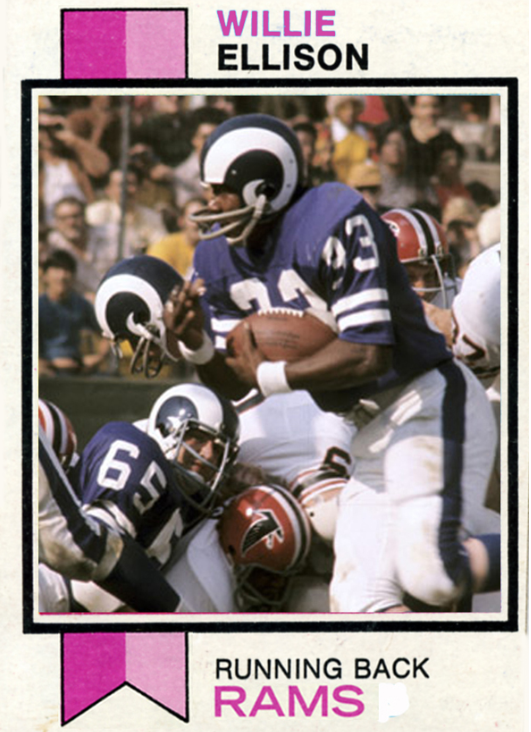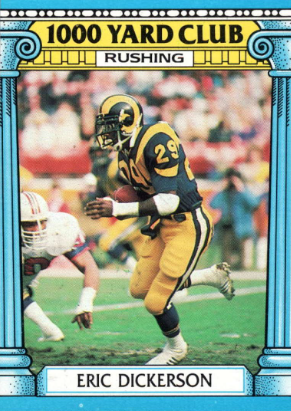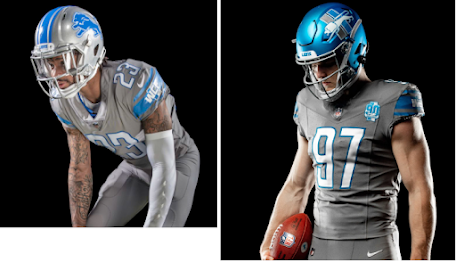The Rams' franchise spans 86 years and three cities - Cleveland, Los Angeles and St. Louis - and it includes some of the league's most productive and decorated running backs.
Halll-of-Famers Eric Dickerson, Marshall Faulk, Ollie Matson and Jerome Bettis are among them. So are Steven Jackson and Todd Gurley, Tank Younger, Deacon Dan Towler, and Lawrence McCutcheon. There league MVPs, All-Pros, Offensive Players of the Year, and league leaders in rushing, TDs and yards from scrimmage.
And, of course, Gold Jackets.
But who had the best single season? Not the best career; the best career year? You're about to find out.
I've compiled a list of the top 20, taking one season from each player and then ranking it. The criteria are more than just rushing yards. That would be too easy. More is included, like receiving, ball security and postseason honors allowing us to compare players with their peers. With a franchise that began in 1937, a great rushing total in the 1940s wouldn't make the top 100 in 2022.
A historical perspective and a bit of the eye test also help rank players' seasons. So here goes ...
20.
Ollie Matson, 1959—The Rams traded nine players to get Matson, and in his first year, a miserable 2-10 season, he gained 854 yards, ran for six touchdowns and had a 5.4 yards-per-rush average.
He was a second-team All-Pro (UPI). It was not a stellar year, but it was his best as a Ram and good enough to crack the top 20.
19.
Willie Ellison, 1971—Ellison gained exactly 1,000 yards. His 247 yards rushing against New Orleans set a then-NFL record and a 138-yard game in Atlanta accounted for two-fifths of that total. But he had seven games of under 50 yards rushing, so his 1,000-yard season ranks lower than some on this list with fewer yards.
Still, he was the NFL Offensive Player of the Week for his record-setting day, a second-team All-NFC selection and was voted to the Pro Bowl.
18.
Jim Bertleson, 1973—After a solid rookie seaso, the man Texas coach Darrell Royal called the "finest football player" he ever coached stepped it up in 1973. He went to the Pro Bowl as an injury replacement and complemented Lawrence McCutcheon in his breakout year. He ran for 854 yards of the 2,925 that the Rams gained rushing that year. He was also a solid punt returner.
17.
Les Josephson, 1967—"Josey" rode the bench in George Allen's first year in Los Angeles after having played quite a bit in his previous two. But the next year he won the starting halfback job and had 800 yards rushing and 400 yards in receptions. He was also a Pro Bowler on the NFL Western Conference squad.
One of the hardest runners in Rams' history, he tore his Achilles the next season and never repeated the production of his career year.
The Rams went 11-1-2, reached the playoffs for the first time since 1955 and Josephson got his 800 yards despite not having a 100-yard game. He ws the definition of a "solid running back."
16.
Cullen Bryant, 1980—Drafted to play safety, Bryant was quickly moved to running back and, just as quickly, kept getting bigger and bigger. On a team with strong guys, he may have been the strongest.
He was a great blocker but not an explosive runner when he finally became a starter in 1978. The 4.5 speed that allowed him to be an excellent kick returner was long gone, as was his ability to keep his weight at 225 pounds. He was listed at 238 pounds but may have been heavier.
But in 1980 something happened. The Rams finally began to throw the ball well after a decade of opponents ganging up to defend likely running plays. For the first time in years, they had to account for passing strikes downfield. Rams' halfbacks kept getting hurt, so that position was by committee. But Bryant was the constant, the mainstay, the unsung hero of the Rams' offense that year.
He led the team in rushing and receiving and escorted other backs as the Rams led the NFL in rushing with 2,999 yards. With the Rams' elite offensive line and Bryant's lead blocking, the club had six games of 215 rushing yards.
That doesn't happen without the steadying influence of Bryant, who had an 800-yard, 50-catch season with a 4.4 rushing average -- far above the 3.7 career average he had prior to 1980. How, you may ask, can Bryant's 1980 be included when Cleveland Gary's 1,125-yard, 52-catch year is not? Didn't Gary have over 300 more rushing yards and essentially the same number of receptions?
Good questions. But Bryant was more vital, and this list isn't only about stats; it's about recognizing seasons with impact. A year like this deserves to be recognized.
15.
Greg Bell, 1988—Bell was never spectacular, but he did have two good seasons with the Rams after going to Anaheim in the Eric Dickerson trade. The Rams acquired a pile of picks and blew most of them, but they gained some return on Bell.
In 1988 he scored 18 times, including 16 rushing TDs (he led the NFL in both), and ran for 1,212 yards. Bell also led the NFL in rushing touchdowns in 1989.
14.
Wendell Tyler, 1981—Tyler was a bright spot on a team that had a miserable season, running for 1,074 yards and 13 touchdowns. He also caught five scoring passes to total 17 TDs from scrimmage, second to only Chuck Muncie that year.
Worth noting: He accomplished this in a season where his offensive line was depleted because of injuries. Only All-Pro center Rich Saul played all 16 games. The other starters missed 28 games, with backup center Doug Smith having to play guard and tackle.
Tyler had a similar year in the 1982 strike-shorted season, one that impressed Bill Walsh so much that he traded for him in 1983 to pair with his new rookie fullback, Roger Craig. There, the former UCLA Bruin had three good seasons and got himself a Super Bowl ring.
13.
Tank Younger, 1954—Younger was a great two-way player, a running back on offense and a linebacker on defense.
As a running back, he was part of the "Bull Elephant" backfield that the Rams sometimes used. It deployed three 225-pound running backs (Dick Hoerner, Paul "Tank" Younger and "Deacon" Dan Towler), and the Rams used it when they wanted to pound opponents.
Essentially, the "Bull Elephant" presented a three-fullback offense and was not an every-down offense. The Rams would contrast it with three halfbacks when they wanted to open up their offense.
By 1954, though, Younger was a cog in the offense, not part of a gimmick backfield. In his career year, he outgained Towler, one of the NFL's top running backs for three years on fewer carries.
Younger led the NFL with a 6.7 yards-per-carry average and was a second-team All-Pro despite missing the final four games. Against the Bears in Week 5, he tore up the Monsters of the Midway with 186 rushing yards and two touchdowns.
12.
Ron Waller, 1955—As late as the 1980s, Los Angeles-based writers would still mention Waller's rookie season of 1955. No, the numbers aren't that impressive, but he passed their eye tests.
Waller was a quick, elusive back that Sid Gillman used to the fullest, but injuries kept him from sustained success. In his initial season, though, he was first-team All-Pro by UPI and second-team All-Pro on the other two major wire service teams - AP and NEA was a also Pro Bowler.
A good kick returner, he led the NFL in all-purpose yards which includes returns as well as rushing and receiving yards.
11.
Charles White, 1987—Usually when a player leads the NFL in rushing and rushing touchdowns, is a consensus first-team All-Pro, All-NFC and goes to the Pro Bowl, he'd be high on any list. But because it was a strike season, he gets moved down a little to 11th.
He was also the PFWA Comeback Player of the Year.
To White's credit, his best game was a 213-yard outing in St. Louis that was not against replacement players. In non-scab games, he still rushed for over 1,000 yards-- a credit to the NFL's best run-blocking offensive line.
10.
Jon Arnett, 1958—The "Jaguar," Arnett was the second overall pick of the 1957 draft out of USC. He was a local golden boy - born and raised in L.A. -- and was a big deal in his day. He became what the Rams hoped Waller would be.
In his second NFL season, he had his best year on a pretty good 8-4 team when Gillman used the Jaguar as a runner, receiver and returner. He was fifth in the NFL in rushing, 10th in receiving, first in punt return average, ninth in kick return average and second in all-purpose yards.
Though the numbers aren't eye-popping by the standards of later generations, they were excellent given how backs were used in the 1950s. The wire services agreed, naming him a consensus first-team All-Pro, while coaches voted him to his first Pro Bowl.
Arnett was fast and elusive, and Gillman sometimes lined him up as a receiver, usually in the slot but occasionally outside. Listed at 197 pounds, he was closer to 205, so he had more beef than often thought.
9.
Dick Bass, 1962—In his career year, Bass became the first Rams' player to run for 1,000 yards, and he did it on a 1-12-1 team. His 1966 season was considered when he helped coach George Allen take the Rams out of the NFL's basement, but in 1962 he did more with less.
He was first-team All-Pro (UPI) and second-team, according to AP and NEA. His 1,033 yards rushing ranked third in the NFL, as did his 5.3 yards per attempt. He also caught 30 passes, including two for scores. Prior to his career year, most of his impact was as the NFL's leading kick returner, something a Rams' player wouldn't do again until 1981.
Bass was a short (5-9), compact fullback, built low-to-the ground like a manhole cover. His best game was against the Bears in December when he ran for 169 yards on 20 carries and a touchdown.
8.
Johnny Drake, 1940—Nicknamed "Zero," Drake was the first Rams' running back to be a consensus first-team All-Pro when he led the NFL in rushing touchdowns (he did it the year before, too) and was second in rushing. He even stopped and popped two touchdown passes.
For the first five years of the Rams' existence, "Zero" Drake was the best player on the Cleveland Rams.
7.
Dan Towler, 1952—Towler was the featured ball carrier this season, leading the NFL in rushing and rushing TDs for an offense that was passing the NFL silly in the late-1940s and early 1950s. He also averaged 5.7 yards a carry, was a consensus All-Pro and was named to the second of his four Pro Bowls. From 1951-54, only Hall-of-Famer Joe Perry ran for more yards, and no one had more rushing TDs than the 1950 25th-round draft pick.
6.
Jerome Bettis, 1993—As a rookie, he didn't exactly explode onto the NFL scene. It took time.
In his first month, Bettis averaged 39.5 yards rushing per game and 3.9 yards a carry. But after that, his numbers jumped to 105.9 per game, including five yards a pop, with Better named NFC Offensive Player of the Week after rushing for 212 yards in Week 15.
Bettis was the consensus NFL Offensive Rookie of the Year, a first-team All-Pro and a Pro Bowler. His 1,429 yards still rank fifth in team history for a single season.
5.
Lawrence McCutcheon, 1974—The only knock on "Clutch's" '74 season is that he wasn't used in short-yardage and goal-line situations. "Touchdown Tony" Baker did that.
Other than that, it was a tremendous year.
McCutcheon was the Rams' fullback (he didn't move to halfback until 1976) and their best offensive player. He had seasons when he had more rushing yards, TDs or a better yards-per-carry average, but 1974 was his best year.
He was first-team All-Pro on a team chosen by players (NEA) and second-team on the AP and PFWA teams picked by the media. He was also All-NFC and went to his second Pro Bowl.
His 1,109 yards rushing ranked fourth in the NFL, and his 4.7 yards-per-attempt were fifth. He also had a career-high 39 receptions for 408 yards and 1,512 yards from scrimmage, which was second in the NFL.
It's hard to compare yardage totals from players in a two-back era to those in the one-back period, roughly the early 1980s to now. In previous generations, fullbacks and halfbacks split carries more evenly. Rather than one having 350-400 carries, he might have 225 with the other getting 150-175.
The numbers may not be as impressive as others on this list behind McCutcheon, but he was as important to the Rams as anyone ahead of him.
4.
Steven Jackson, 2006—No Rams' running back ever ran harder than Jackson. Others ran hard, no doubt, but Jackson was a beast -- even on a mediocre 2006 team when he was a second-team All-Pro and a Pro Bowler. One writer even gave him an Offensive Player-of-the-Year vote.
He was the NFC Offensive Player of the Month for December when he rushed for 597 yards, caught 27 passes and scored ten times. He set career-highs in nearly everything that season, including an NFL-best 2,334 yards from scrimmage second-best in Rams history.
Jackson had 1,528 yards rushing (fifth in the NFL) and 90 receptions (seventh in the NFL), both notable franchise figures. His rushing total is fourth-best in Rams' single-season history, while no running back has ever caught more passes.
3.
Todd Gurley, 2017—He led the NFL in yards from scrimmage, rushing touchdowns and total touchdowns to the Rams to their first winning season since 2003.
In 15 games, he ran for 1,305 yards, had 788 yards in receptions and averaged 12.8 yards per catch - better than some wide receivers. He was the AP and PFWA Offensive Player of the Year, runner-up in the MVP voting, a consensus All-Pro and a first-time Pro Bowler.
Three times he was the NFC Offensive Player of the Week -- in Week 4s, 15 and 16. In Week 15, he ran for four touchdowns and 152 yards in a 42-7 demolishment of the Seahawks. One week later, he caught 10 passes for 158 yards in a win over the Titans. He was also twice named NFC Offensive Player of the Month.
His 2018 season was also considered. That was the year he scored two more touchdowns and left a couple more on the table by choosing to run out the clock instead of score. But, in a close call, 2017 is the pick.
2.
Eric Dickerson, 1984—Rushing for an NFL-record 2,105 yards is an incredible feat. To do it when your passing offense offers little help makes it more incredible.
In his career year, he was the NFC Offensive Player of the Week twice (Weeks 10 and 15), a consensus All-Pro, and a Pro Bowler. He was the NFC Player of the Year and runner-up in the MVP voting (Dan Marino's monster year took the prize).
Twice he ran for over 200 yards and a third time he came close, finishing with 191 yards. His 2,244 yards from scrimmage led the NFL and is the third-highest in club history, while he also tied for the league lead in rushing touchdowns with 14.
If there was a knock, it was only that Dickerson was a fumbler. He had 14 in 1984 and averaged 11 a season with the Rams. Nevertheless, they were 10-6 in 1984. Without Dickerson, they'd have been more like 4-12.
1.
Marshall Faulk, 2000—Faulk's 1999 season was tempting with the Super Bowl ring, 1,000 yards rushing and another 1,000 receiving ... as was 2001. In fact, he probably had the three best individual seasons by a Rams' running back - in 1999, 2000 and 2001.
Any of the three could top this list.
In 2000 he was a four-time Offensive Player of the Week, the consensus MVP, Offensive Player of the Year, consensus All-Pro, All-NFC and a Pro Bowler. In October and December, the NFL named him the NFC Offensive Player of the Month.
He scored a team-record 26 touchdowns to lead the NFL, 18 rushing (leading the NFL and tying the club mark) and eight more on receptions. Twice he ran for more than 200 yards, four times he had 85 or more receiving yards and five times he scored three or more touchdowns -- three of them part of four-TD days.
He also led the NFL in yards per rush and, best of all, never fumbled.
He was also one of the best-ever backs at pass protection. When he wasn't breaking big runs or making catches, he kept blitzers off of Kurt Warner. In 2000 he was the best player in the NFL, and it was the best season by a Rams' running back.























